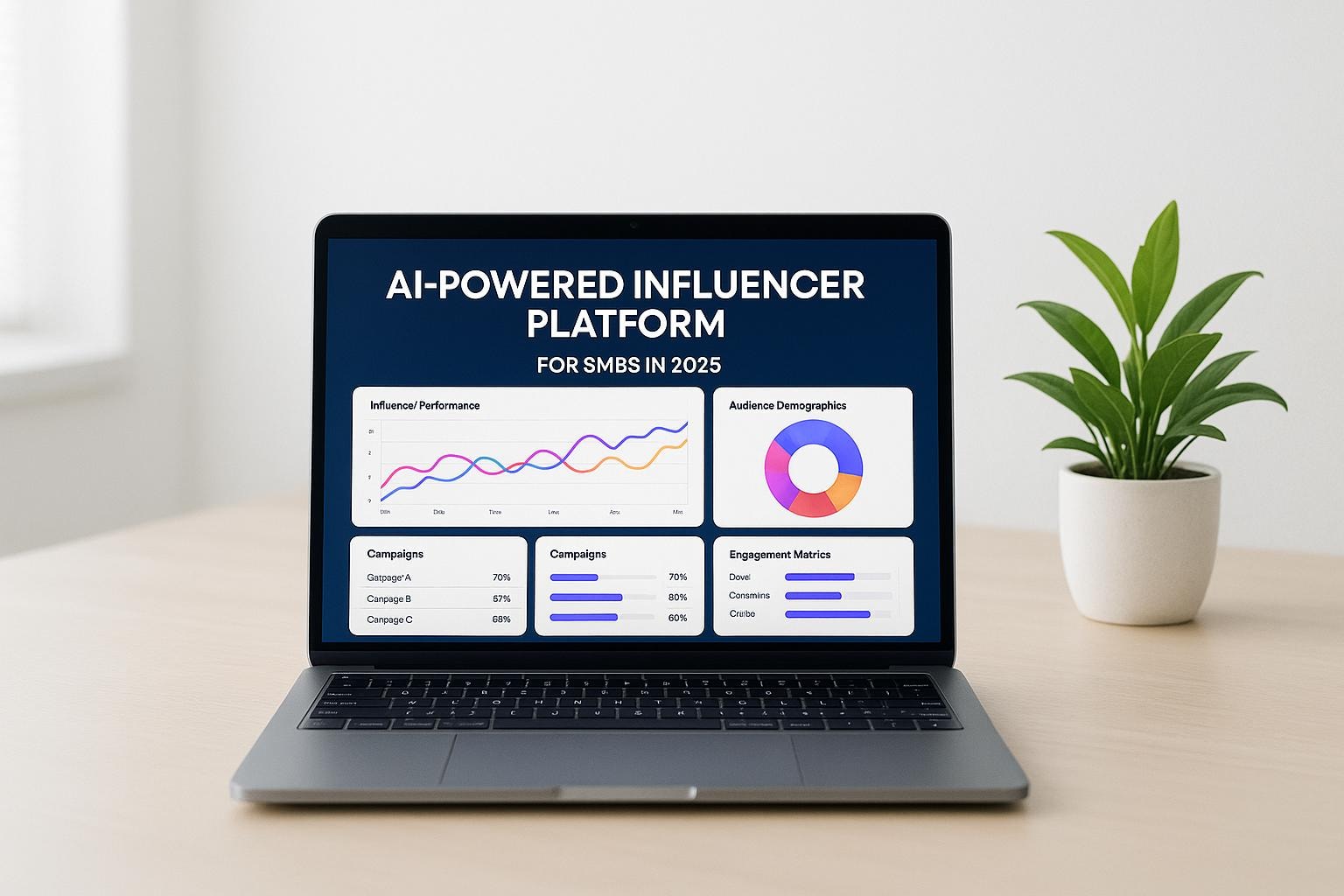
AI-Powered Influencer Platforms for SMBs in 2025
Small businesses are turning to AI to simplify influencer marketing. Why? It saves time, improves targeting, and helps manage campaigns more efficiently. In 2025, influencer marketing is a $21 billion industry, and SMBs are tapping into it with tools that automate tasks like finding influencers, tracking performance, and preventing fraud.
Key Takeaways:
- Micro-influencers are driving higher ROI for SMBs with niche, engaged audiences.
- AI platforms automate influencer discovery, campaign management, and ROI tracking.
- Fraud detection ensures SMBs avoid influencers with fake followers.
- Predictive analytics help forecast campaign success before launch.
Top Platforms for SMBs:
- HypeAuditor ($299/month): Focuses on audience quality and fraud detection.
- Upfluence ($795/month): Offers multi-channel campaigns and e-commerce integration.
- AspireIQ ($1,000/month): Ideal for long-term influencer relationships.
- Grin (Custom pricing): Combines CRM tools with social listening for campaign management.
- CreatorIQ (Custom pricing): Provides advanced analytics and workflow automation.
Quick Comparison:
| Platform | Starting Price | Best For | Key Features | G2 Rating |
|---|---|---|---|---|
| HypeAuditor | $299/month | Budget-conscious SMBs | Fraud detection, audience quality | 4.4/5 |
| Upfluence | $795/month | Established SMBs | ROI tracking, e-commerce sync | 4.5/5 |
| AspireIQ | $1,000/month | Long-term partnerships | Predictive analytics, AI matching | 4.6/5 |
| Grin | Custom pricing | Systematic influencer programs | CRM-style tools, social listening | 4.7/5 |
| CreatorIQ | Custom pricing | Scaling influencer campaigns | Workflow automation, analytics | 4.5/5 |
How to Choose the Right Platform:
- Look for clear pricing and integration with your current tools (e.g., Shopify, WooCommerce).
- Prioritize fraud detection if budget is tight or predictive analytics for data-driven decisions.
- Ensure ease of use with intuitive dashboards and responsive customer support.
Best AI Influencer Platforms for SMBs in 2025
For small and medium-sized businesses (SMBs) looking for affordable and easy-to-use AI solutions, these five platforms shine in 2025. They combine advanced tools with pricing that works for SMBs, making influencer marketing more accessible and effective. Below, we break down the standout features, pricing, and usability of each platform.
Upfluence
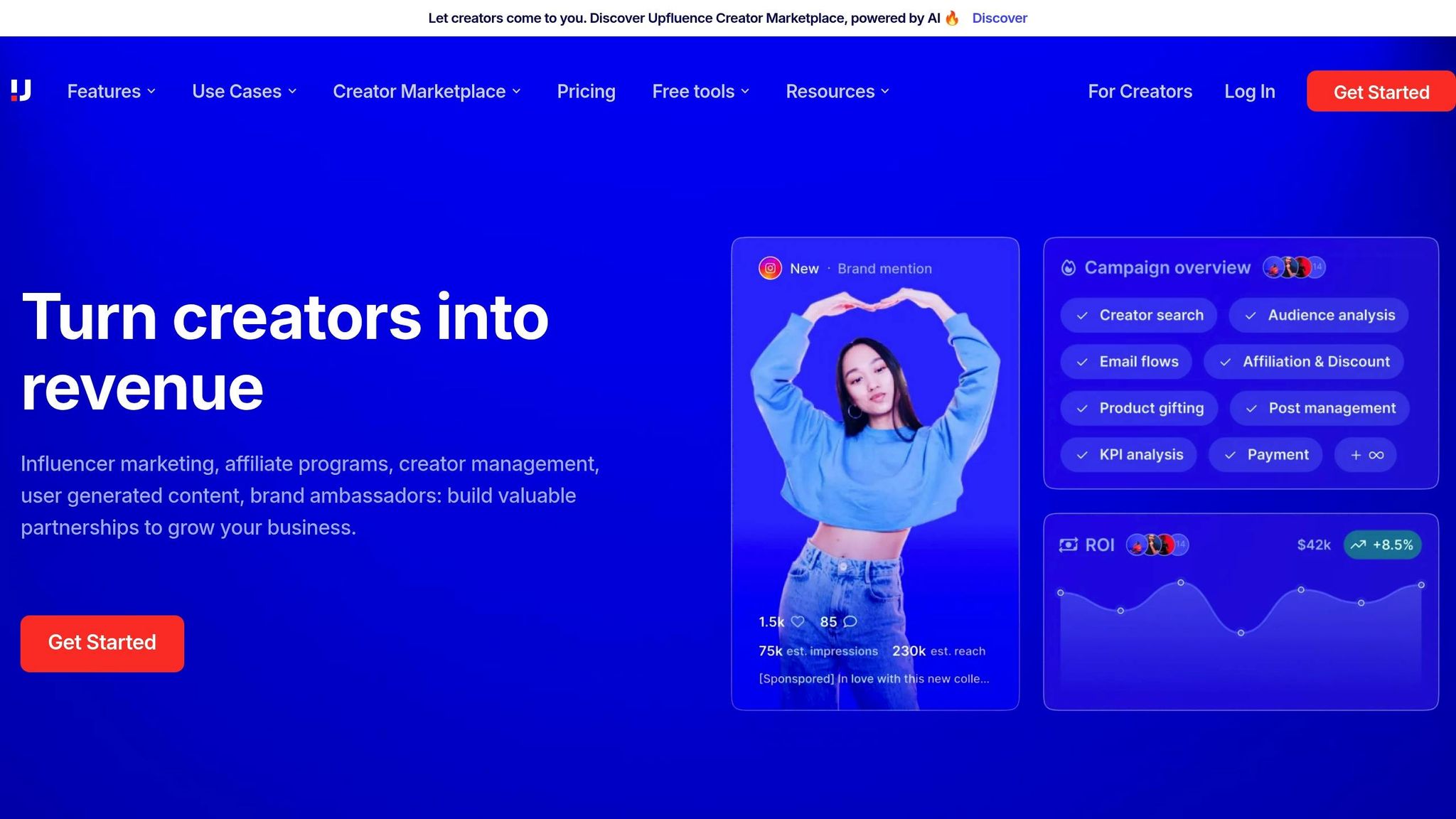
Upfluence specializes in real-time influencer discovery and automated outreach. Its AI connects brands with influencers based on audience demographics, content style, and brand alignment. It even identifies potential influencers from your existing customer base. With seamless integration into platforms like Shopify and WooCommerce, Upfluence also simplifies campaign management with ROI tracking, detailed analytics dashboards, and automated contract generation. Starting at $795/month, the platform is highly rated with a 4.5/5 score on G2. It’s a great choice for managing campaigns across Instagram, YouTube, and TikTok.
AspireIQ (Aspire)
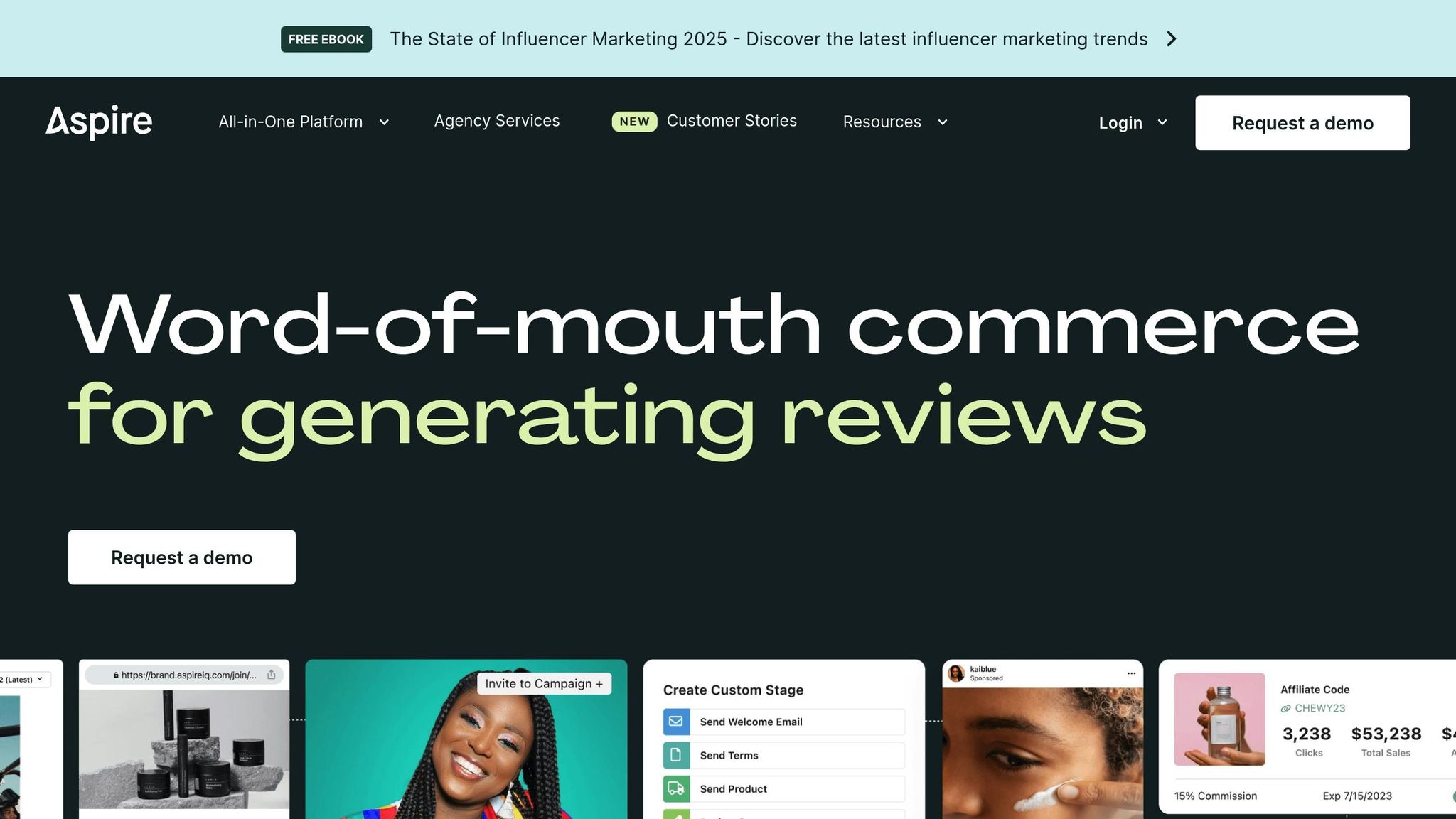
AspireIQ uses image recognition to match brands with influencers whose content aligns with their visual identity. Designed to foster long-term partnerships, its AI ensures consistent brand messaging and nurtures ongoing collaborations. Predictive analytics let users estimate campaign performance before launch, enabling smarter budget planning. With a user-friendly interface and affordable onboarding, AspireIQ is perfect for SMBs new to influencer marketing. Pricing starts around $1,000/month, with a 4.6/5 G2 rating. It integrates smoothly with Instagram, TikTok, and Shopify.
Grin
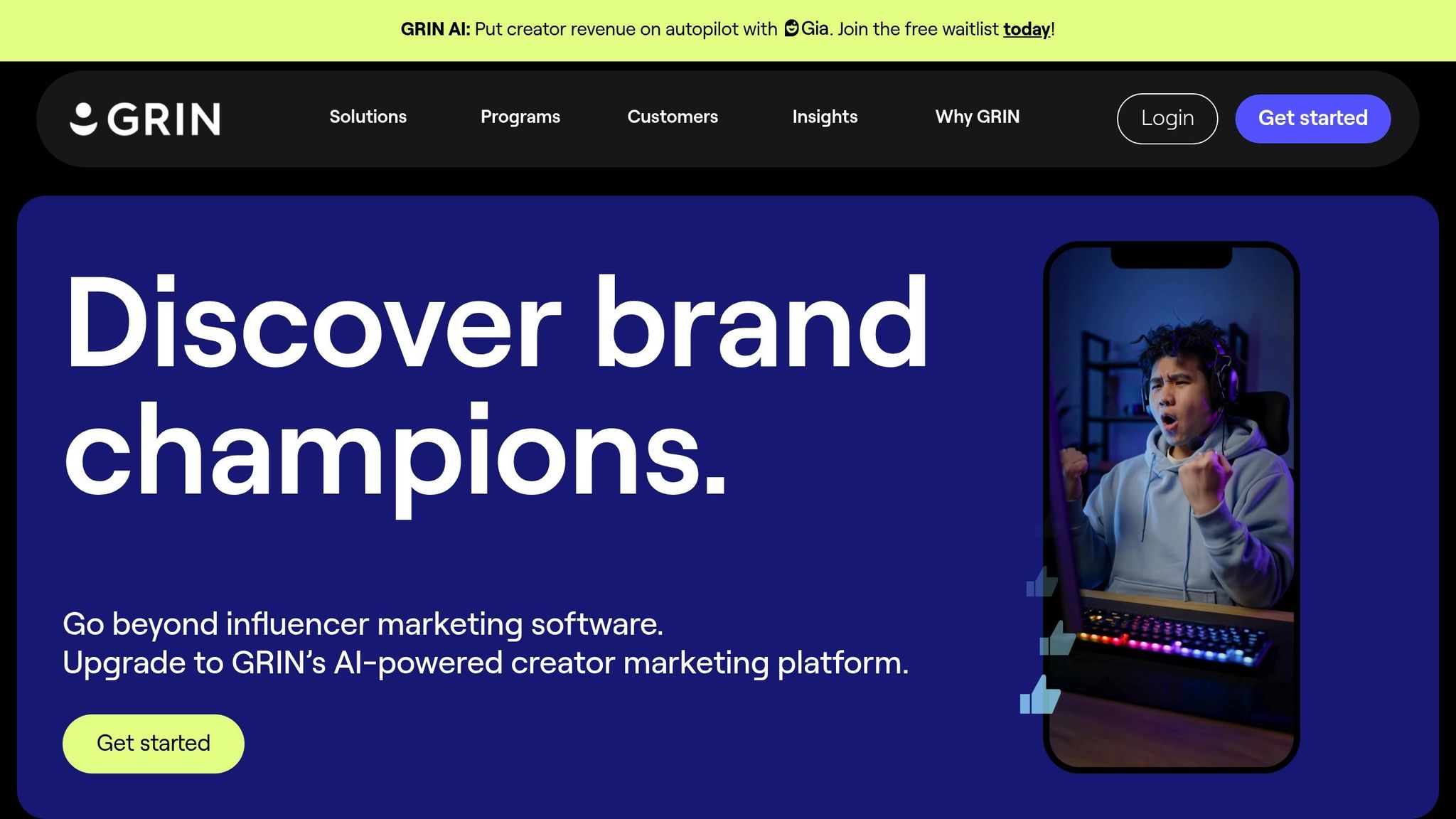
Grin’s AI tools focus on analytics and social listening, streamlining influencer recruitment and relationship management. It excels at product seeding and affiliate management, thanks to its e-commerce integrations. These features allow users to track product deliveries and monitor resulting sales. While Grin operates on custom pricing, it’s considered a cost-effective option for SMBs juggling multiple campaigns. The platform holds an impressive 4.7/5 rating on G2, reflecting its value and reliability.
HypeAuditor
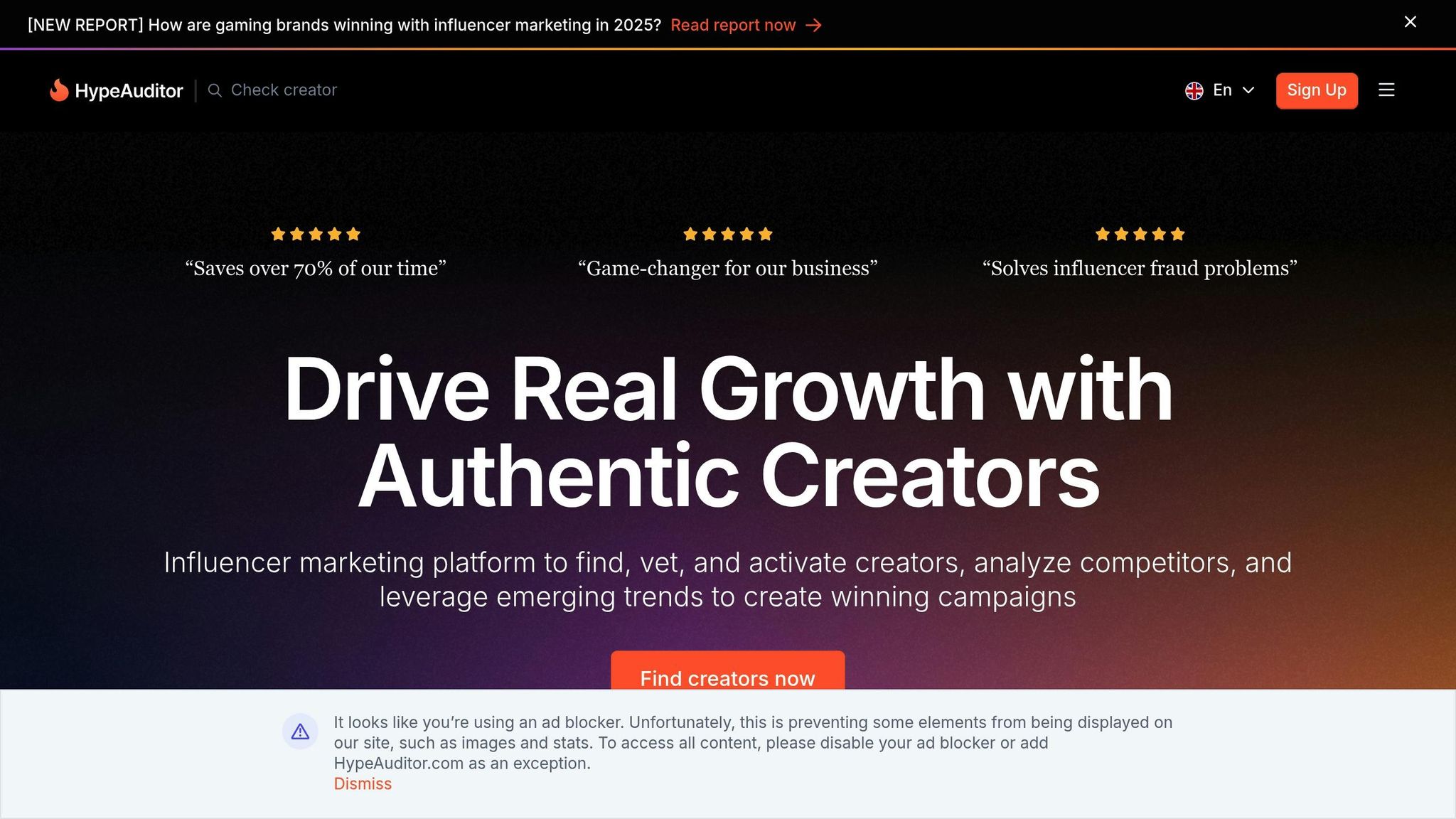
HypeAuditor stands out for its focus on audience quality and fraud detection. Its AI evaluates engagement to identify fake followers, ensuring marketing dollars are spent on genuine audiences. The platform provides detailed reports on follower quality, engagement rates, and audience demographics, paired with tools for optimizing campaign performance. With plans starting at just $299/month, HypeAuditor is a budget-friendly choice for SMBs and has a 4.4/5 G2 rating.
CreatorIQ

CreatorIQ delivers enterprise-grade AI features tailored for SMBs, including audience authenticity checks, workflow automation, and predictive analytics. It simplifies complex influencer campaigns by automating tasks and generating in-depth performance reports. Now offering competitive pricing packages for SMBs, CreatorIQ combines sophistication with accessibility. It holds a 4.5/5 rating on G2, making it a strong option for businesses looking to scale their influencer programs without added complexity.
Here’s a quick comparison of these platforms:
| Platform | Key AI Features | Best For | Starting Price | G2 Rating |
|---|---|---|---|---|
| Upfluence | Real-time discovery, e-commerce sync | Multi-channel campaigns | $795/month | 4.5/5 |
| AspireIQ | AI matching, image recognition | Long-term partnerships | $1,000/month | 4.6/5 |
| Grin | CRM-style management, social listening | Systematic programs | Custom | 4.7/5 |
| HypeAuditor | Fraud detection, audience quality | Budget-conscious SMBs | $299/month | 4.4/5 |
| CreatorIQ | Predictive analytics, workflow automation | Advanced analytics | Custom | 4.5/5 |
Each of these platforms brings unique strengths to the table, helping SMBs maximize ROI through smarter targeting, streamlined workflows, and data-driven strategies.
How SMBs Should Choose the Right Platform
What to Look for When Choosing a Platform
When selecting a platform, focus on factors that directly influence your marketing success and budget. Start with pricing transparency - hidden fees can quickly add up. Choose platforms that clearly state their monthly costs, setup fees, and any extra charges for premium features.
Next, consider integration capabilities. A good platform should seamlessly connect with tools you already use, like Shopify, WooCommerce, HubSpot, or Salesforce. These integrations make it easier to track purchases, identify influential customers, and consolidate reporting across your marketing channels. Smooth integration also enhances your ability to manage campaigns and measure results.
Scalability is another must-have. As your business grows, your platform should handle increased campaign volumes, more influencer partnerships, and expanded reporting needs - without requiring a total system overhaul.
Ease of use is critical, especially for teams with limited marketing resources. Look for features like intuitive dashboards, automated influencer matching, drag-and-drop campaign builders, and pre-built reporting templates. Platforms such as AspireIQ and Upfluence are often praised for their user-friendly interfaces, which can help SMBs hit the ground running.
When it comes to AI-driven features, focus on what aligns with your specific goals. For example, if fraud detection is a priority, HypeAuditor’s tools for verifying audience authenticity might be a perfect fit. If forecasting campaign performance is more important, AspireIQ’s predictive analytics can help. The key is to choose features that genuinely save time and improve your outcomes.
Lastly, don’t overlook customer support. Responsive support can make the difference between a smooth experience and weeks of frustration. Check reviews on platforms like G2 to get a sense of how other users rate their support experiences.
Here’s a quick comparison of popular platforms and their strengths:
Platform Comparison Table
| Platform | Monthly Cost | Key Strengths | Best Integration | SMB Fit Score |
|---|---|---|---|---|
| HypeAuditor | $299+ | Fraud detection, budget-friendly | Basic e-commerce | Great for budget-conscious SMBs |
| Upfluence | $795+ | Multi-channel campaigns, ROI tracking | Shopify, WooCommerce | Best for established SMBs |
| AspireIQ | $1,000+ | Relationship management, forecasting tools | Instagram, TikTok, Shopify | Ideal for long-term partnerships |
| Grin | Custom pricing | CRM-style management, social listening | Comprehensive e-commerce | Perfect for systematic programs |
| CreatorIQ | Custom pricing | Enterprise features, workflow automation | Advanced analytics tools | Best for scaling businesses |
This table highlights key differences. For instance, HypeAuditor offers an affordable entry point for SMBs new to influencer marketing, while AspireIQ and Upfluence cater to businesses ready to invest in more advanced tools.
Budget Planning and ROI Expectations
To plan your budget effectively, think beyond the monthly subscription fee. SMBs often spend between $99 and $500 per month on entry-level to mid-tier plans. Additional costs can include advanced features, higher campaign volumes, influencer payments, content creation, and setup fees.
Setting clear ROI expectations is just as important as budgeting. AI-powered platforms can significantly amplify campaign results. For example, Sephora used the Influential platform to reach over 1 million people, boosting sales by 25%. Similarly, Coca-Cola’s campaign with Tagger reached 10 million people and increased brand awareness by 15%.
Define your campaign goals before choosing a platform. Whether you want to drive sales, improve brand awareness, or build lasting customer relationships, your objectives should guide your decision. For sales-driven campaigns, strong e-commerce integration is key. For long-term partnerships, prioritize platforms with advanced relationship management features.
Track KPIs like engagement and conversions using real-time analytics. These insights can help you pinpoint top-performing influencers, refine your content strategy, and adjust your budget for maximum impact. Predictive analytics can also guide you toward influencers likely to deliver the best results, allowing for smarter decisions.
Finally, consider the ripple effects of successful campaigns. For example, a boost in customer engagement might lead to more phone inquiries. Tools like Dialzara can help you manage the increased call volume, ensuring you capture every opportunity generated by your marketing efforts.
sbb-itb-ef0082b
How to Get Better ROI with AI Influencer Platforms
How to Set Up Successful Campaigns
The backbone of any successful influencer campaign is setting clear objectives. Are you looking to increase sales, raise brand awareness, or build lasting customer relationships? Having a defined goal helps steer every decision, from picking the right influencers to crafting your content strategy.
AI platforms can take the guesswork out of finding influencers. By analyzing a mix of demographic and behavioral data, these tools help identify the best matches for your campaign. For example, IMAI’s discovery engine scans a database of over 400 million profiles across platforms like YouTube, Instagram, TikTok, Twitch, X, and Snapchat to surface relevant influencers for your brand.
Next, focus on audience authenticity. With AI, you can evaluate an influencer’s credibility, engagement levels, and brand alignment using social media data. This ensures you’re partnering with creators who genuinely connect with their followers. AI tools also streamline communication by generating tailored messaging and content guidelines, saving you hours of manual effort. Platforms like Upfluence combine real-time scanning with automated outreach, making them a favorite among mid-market brands.
To measure success effectively, set up trackable attribution from the start. AI integrates with eCommerce systems, using trackable links or codes to connect sales directly to influencer activity. This eliminates guesswork and clearly shows which creators are driving results.
As influencers often work across multiple platforms, unified dashboards are becoming essential. These tools allow you to track campaigns spanning Instagram, YouTube, TikTok, and more, providing a complete view of performance across channels.
Once your campaign is live, real-time insights become critical for staying on track.
Using AI Data to Improve Performance
After launching your campaign, real-time AI data helps you refine and optimize it. Dashboards provide live updates, letting you monitor creators and track key metrics like views, clicks, and revenue. This allows you to make immediate adjustments when needed.
Predictive analytics take it a step further by forecasting which influencers are most likely to succeed with your brand. Instead of waiting for results, you can allocate resources more strategically. AspireIQ, for example, uses image recognition and behavioral data to pair brands with influencers whose followers are statistically more likely to convert.
AI tools also analyze engagement patterns and audience sentiment through natural language processing. By identifying the topics and tones that resonate most, you can tweak your content strategy mid-campaign for better results. This flexibility gives AI-powered campaigns an edge over traditional approaches.
Automated reporting features make it easy to demonstrate ROI. Platforms like Skeepers offer "Wrap Report" functions, compiling performance metrics and influencer content into shareable formats. These reports not only prove campaign value but also build trust with stakeholders. Many tools now integrate directly with eCommerce platforms like Shopify or CRM systems like Klaviyo, treating influencers as an extension of your sales team. This integration helps pinpoint which partnerships are driving revenue - not just engagement.
Mistakes SMBs Should Avoid
To maximize ROI, avoid these common missteps:
- Over-relying on automation: While AI provides valuable insights, it’s not perfect. Always apply human judgment when reviewing influencer recommendations, especially for partnerships that could significantly impact your brand image.
- Skipping authenticity checks: Even with AI fraud detection, manually review potential influencers’ recent content and engagement. Look for genuine interactions rather than suspicious spikes or generic comments.
- Failing to set clear goals: Without specific objectives, such as sales conversions or brand awareness, you can’t fully leverage AI insights to fine-tune your campaign. Define success metrics upfront to stay focused.
- Ignoring real-time data: Some SMBs set up campaigns and only review results at the end. This approach misses opportunities for mid-campaign adjustments that could improve outcomes. Regularly check performance data and make tweaks as needed.
- Prioritizing follower counts over engagement quality: A smaller, highly engaged audience often delivers better ROI than a larger but disengaged one. AI metrics like audience authenticity scores can help identify the best partners for your goals.
- Neglecting content rights management: Legal issues can arise if you don’t secure the rights to repurpose influencer content. Use platforms that automate rights management to avoid complications down the line.
- Underestimating budget needs: A successful campaign can lead to increased customer inquiries. Make sure you have systems in place, like Dialzara, to handle higher call volumes and avoid missing potential sales opportunities.
- Poor dashboard management: Messy data tracking reduces the value of AI insights. Choose platforms with intuitive interfaces and standardized reporting. Regularly audit your data to ensure accuracy across campaigns.
What's Next for AI in SMB Influencer Marketing
New Trends Coming in 2025 and Beyond
By 2025, AI will be a core part of influencer marketing strategies. With trends shifting at lightning speed, brands need tools that help them respond quickly and adjust in real time.
One exciting development is dynamic creative optimization, where AI tweaks content on the fly to match viewer profiles. This means your campaigns can automatically align with individual preferences and behaviors. Automated audience segmentation has also become a game-changer, identifying high-value groups and delivering personalized campaigns without requiring manual effort.
AI is also stepping up its predictive game, offering tailored recommendations and behavior-triggered messages to meet customer needs. On top of that, platforms are integrating with e-commerce systems, treating influencer partnerships as long-term strategic assets. By analyzing social data, they can measure an influencer's impact on consumer sentiment and purchasing behavior. These advancements are paving the way for SMBs to refine their influencer strategies and stay competitive.
Take Starbucks, for instance. Their AI platform, DeepBrew, uses customer data to create personalized offers. This approach has boosted both engagement and revenue while cutting down on waste.
How SMBs Can Prepare for AI Changes
To keep up with these advancements, SMBs need to rethink their strategies. A good place to start is linking your CRM data with AI-driven ad tools. This can give you the kind of precise targeting that used to be limited to big corporations.
Shift your perspective on influencers - think of them as long-term collaborators rather than one-off investments. Platforms now treat creator marketing as a key part of broader business intelligence efforts. When evaluating influencer content, look beyond likes and shares. Consider how well it connects with your customers’ values and needs.
Real-time insights are another must-have. These tools let you pivot quickly when trends or cultural moments shift unexpectedly. If you're new to this, free tools like CreatorGPT can help you dip your toes into influencer marketing before committing to paid platforms. As your campaigns grow, make sure you have systems like Dialzara in place to handle an increase in customer interactions efficiently.
Main Points for SMBs
For SMBs, success in this new era hinges on blending technology with authentic engagement. AI-powered personalization now allows brands to deliver content and offers that feel genuinely tailored to each customer, helping smaller businesses compete with larger players through laser-focused targeting. The right AI tools can help you find the best influencer partnerships, generate fresh content ideas, and identify what’s working - all while saving time and effort.
Real-time data and advanced segmentation are crucial for staying agile, especially when cultural or market shifts demand quick adjustments. The SMBs that thrive will be those that use AI as a strategic tool while continuing to build genuine relationships with both creators and customers. By staying adaptable, data-focused, and customer-centered, you'll be well-positioned to succeed in this ever-changing landscape.
FAQs
What are the key benefits of AI-powered influencer platforms for small and medium-sized businesses (SMBs)?
AI-driven influencer platforms open up new possibilities for small and medium-sized businesses (SMBs), offering tools that are affordable and simple to use. These platforms make influencer marketing accessible, even for businesses working with tight budgets.
By leveraging AI, SMBs can efficiently find the right influencers, anticipate how campaigns will perform, and simplify the collaboration process - all without requiring a large marketing team. The automation and insights provided cut down on time spent and eliminate much of the guesswork, allowing businesses to concentrate on building their brand with greater confidence.
What should small and medium-sized businesses look for in an AI influencer platform to meet their goals and stay within budget?
When selecting an AI influencer platform, small and medium-sized businesses (SMBs) should focus on a few essential factors to find the right fit for their needs and budget. First, prioritize ease of use - a platform with a simple, user-friendly interface can save time and reduce frustration, especially for teams with limited technical expertise.
Next, think about affordability. It's important to choose a solution that balances cost and value, ensuring it aligns with your financial resources while still delivering meaningful results.
You’ll also want to evaluate the platform's scalability. As your business grows, the platform should be able to adapt to your expanding needs. Another key consideration is its ability to provide data-driven insights. These insights can help you fine-tune your campaigns for better performance.
Lastly, look for features designed specifically for your industry and target audience. This tailored approach can help you achieve stronger engagement and more impactful outcomes.
How can small and medium-sized businesses (SMBs) track the ROI of influencer marketing campaigns with the help of AI tools?
Measuring the return on investment (ROI) for influencer marketing campaigns becomes much easier with the help of AI tools. These platforms can analyze critical performance metrics like engagement rates, conversions, and audience reach. By automating the process of data collection and analysis, AI not only saves time but also provides insights that can help fine-tune your future campaigns.
While many influencer marketing tools are designed to handle campaign analytics, Dialzara steps in to address a different but equally important need for small and medium-sized businesses (SMBs). This AI-driven virtual phone answering service helps businesses manage a surge in customer inquiries efficiently. By automating customer interactions, Dialzara not only saves time and cuts costs but also ensures businesses can maintain high-quality customer service. This means SMBs can dedicate more energy to strategic efforts, such as influencer marketing, without compromising on customer care.
Related Posts
Ultimate Guide to AI for Influencer Marketing
Explore how AI is revolutionizing influencer marketing, enabling small businesses to enhance efficiency, reduce costs, and drive impactful campaigns.
10 Best AI Tools for Influencer Identification 2024
Explore the top AI tools for influencer identification in 2024, simplifying campaign management and enhancing data-driven marketing strategies.
How AI Identifies the Right Influencers for Your Brand
AI revolutionizes influencer marketing by automating influencer selection and analysis, enhancing efficiency and campaign effectiveness.
AI Tools for SMBs: Influencer Marketing Use Cases
AI tools are revolutionizing influencer marketing for SMBs, streamlining influencer discovery, campaign management, and analytics for better ROI.
